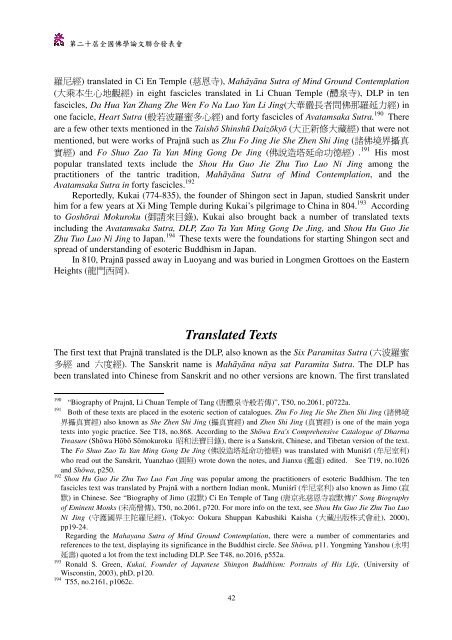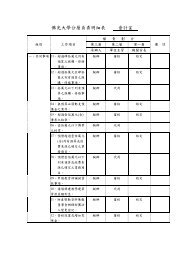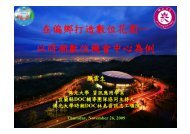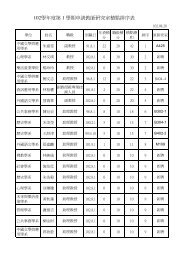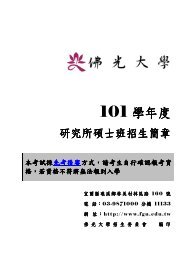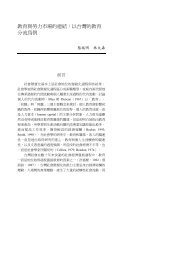【A 場】第一場論文集 - 佛光大學
【A 場】第一場論文集 - 佛光大學
【A 場】第一場論文集 - 佛光大學
- No tags were found...
You also want an ePaper? Increase the reach of your titles
YUMPU automatically turns print PDFs into web optimized ePapers that Google loves.
第 二 十 屆 全峖 國 佛 學 論 文尠 聯 合峯 發 表 會羅訌 尼 經 ) translated in Ci En Temple ( 慈 恩韴 寺 ), Mahāyāna Sutra of Mind Ground Contemplation( 大 乘靭 本 生 心 地 觀 經 ) in eight fascicles translated in Li Chuan Temple ( 醴 泉 寺 ), DLP in tenfascicles, Da Hua Yan Zhang Zhe Wen Fo Na Luo Yan Li Jing( 大 華 嚴詫 長 者 問 佛 那倴 羅訌 延 力 經 ) inone facicle, Heart Sutra ( 般獭 若 波 羅訌 蜜犪 多 心 經 ) and forty fascicles of Avatamsaka Sutra. 190 Thereare a few other texts mentioned in the Taishō Shinshū Daizōkyō ( 大 正 新 修鞈 大 藏 經 ) that were notmentioned, but were works of Prajnā such as Zhu Fo Jing Jie She Zhen Shi Jing ( 諸 佛 境蹜 界 攝 真猙實蹴 經 ) and Fo Shuo Zao Ta Yan Ming Gong De Jing ( 佛 說狄 造 塔 延 命 功 德 經 ) . 191 His mostpopular translated texts include the Shou Hu Guo Jie Zhu Tuo Luo Ni Jing among thepractitioners of the tantric tradition, Mahāyāna Sutra of Mind Contemplation, and theAvatamsaka Sutra in forty fascicles. 192Reportedly, Kukai (774-835), the founder of Shingon sect in Japan, studied Sanskrit underhim for a few years at Xi Ming Temple during Kukai’s pilgrimage to China in 804. 193 Accordingto Goshōrai Mokuroku ( 御 請 來 目 錄 ), Kukai also brought back a number of translated textsincluding the Avatamsaka Sutra, DLP, Zao Ta Yan Ming Gong De Jing, and Shou Hu Guo JieZhu Tuo Luo Ni Jing to Japan. 194 These texts were the foundations for starting Shingon sect andspread of understanding of esoteric Buddhism in Japan.In 810, Prajnā passed away in Luoyang and was buried in Longmen Grottoes on the EasternHeights ( 龍 門 西 岡 ).Translated TextsThe first text that Prajnā translated is the DLP, also known as the Six Paramitas Sutra ( 六 波 羅訌 蜜犪多 經 and 六 度 經 ). The Sanskrit name is Mahāyāna nāya sat Paramita Sutra. The DLP hasbeen translated into Chinese from Sanskrit and no other versions are known. The first translated190“Biography of Prajnā, Li Chuan Temple of Tang ( 唐鞡 醴 泉 寺 般獭 若 傳 )”, T50, no.2061, p0722a.191Both of these texts are placed in the esoteric section of catalogues. Zhu Fo Jing Jie She Zhen Shi Jing ( 諸 佛 境蹜界 攝 真猙 實蹴 經 ) also known as She Zhen Shi Jing ( 攝 真猙 實蹴 經 ) and Zhen Shi Jing ( 真猙 實蹴 經 ) is one of the main yogatexts into yogic practice. See T18, no.868. According to the Shōwa Era's Comprehensive Catalogue of DharmaTreasure (Shōwa Hōbō Sōmokuroku 昭 和 法 寶話 目 錄 ), there is a Sanskrit, Chinese, and Tibetan version of the text.The Fo Shuo Zao Ta Yan Ming Gong De Jing ( 佛 說狄 造 塔 延 命 功 德 經 ) was translated with Muniśrī ( 牟 尼 室 利 )who read out the Sanskrit, Yuanzhao ( 圓 照 ) wrote down the notes, and Jianxu ( 鑑 虛 ) edited. See T19, no.1026and Shōwa, p250.192Shou Hu Guo Jie Zhu Tuo Luo Fan Jing was popular among the practitioners of esoteric Buddhism. The tenfascicles text was translated by Prajnā with a northern Indian monk, Muniśrī ( 牟 尼 室 利 ) also known as Jimo ( 寂默 ) in Chinese. See “Biography of Jimo ( 寂 默 ) Ci En Temple of Tang ( 唐鞡 京 兆 慈 恩韴 寺 寂 默 傳 )” Song Biographyof Eminent Monks ( 宋侗 高珉 僧踶 傳 ), T50, no.2061, p720. For more info on the text, see Shou Hu Guo Jie Zhu Tuo LuoNi Jing ( 守 護 國 界 主 陀 羅訌 尼 經 ), (Tokyo: Ookura Shuppan Kabushiki Kaisha ( 大 藏 出 版 株頶 式 會 社 ), 2000),pp19-24.Regarding the Mahayana Sutra of Mind Ground Contemplation, there were a number of commentaries andreferences to the text, displaying its significance in the Buddhist circle. See Shōwa, p11. Yongming Yanshou ( 永 明延 壽蹢 ) quoted a lot from the text including DLP. See T48, no.2016, p552a.193 Ronald S. Green, Kukai, Founder of Japanese Shingon Buddhism: Portraits of His Life, (University ofWisconstin, 2003), phD, p120.194 T55, no.2161, p1062c.42


